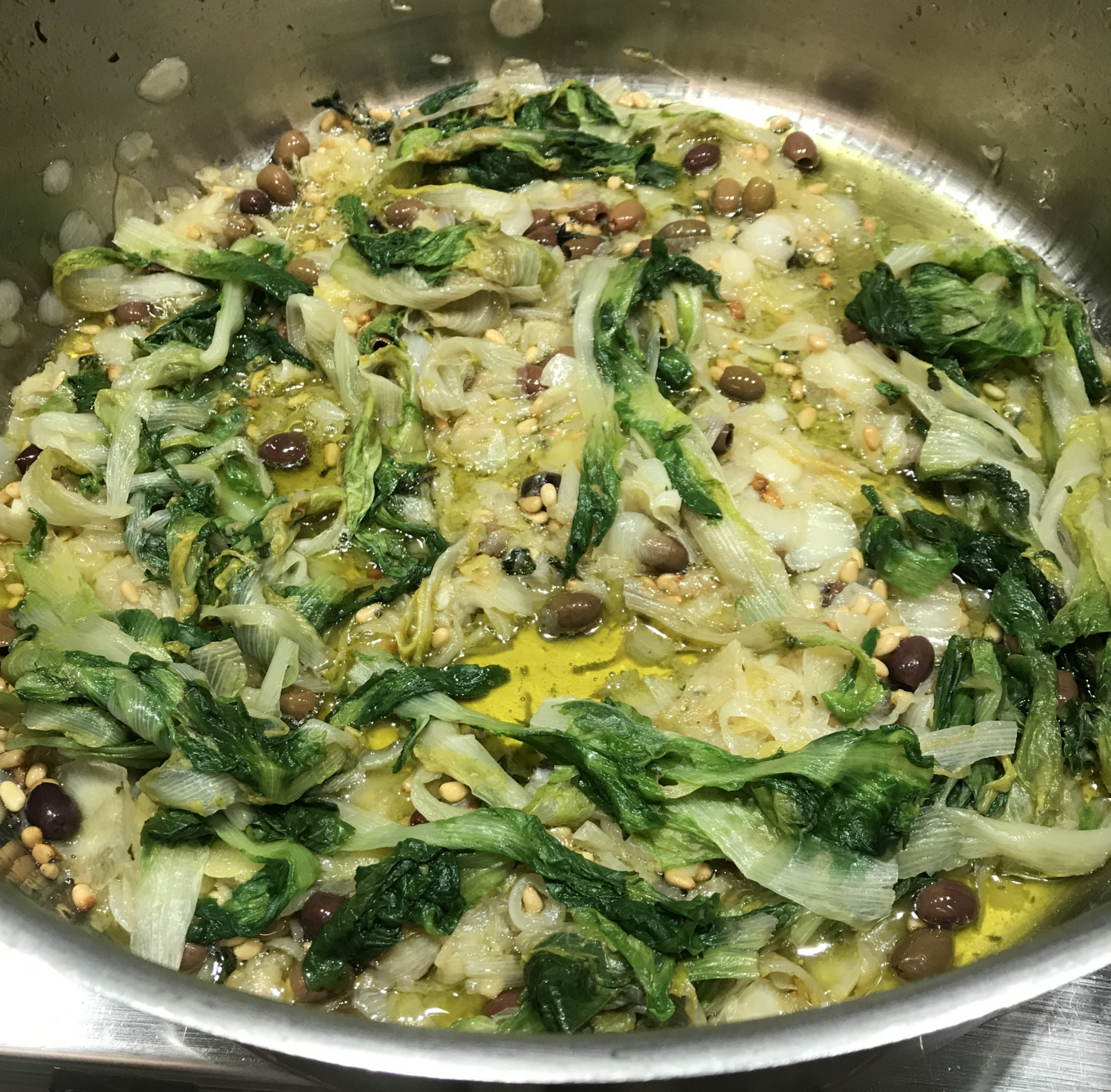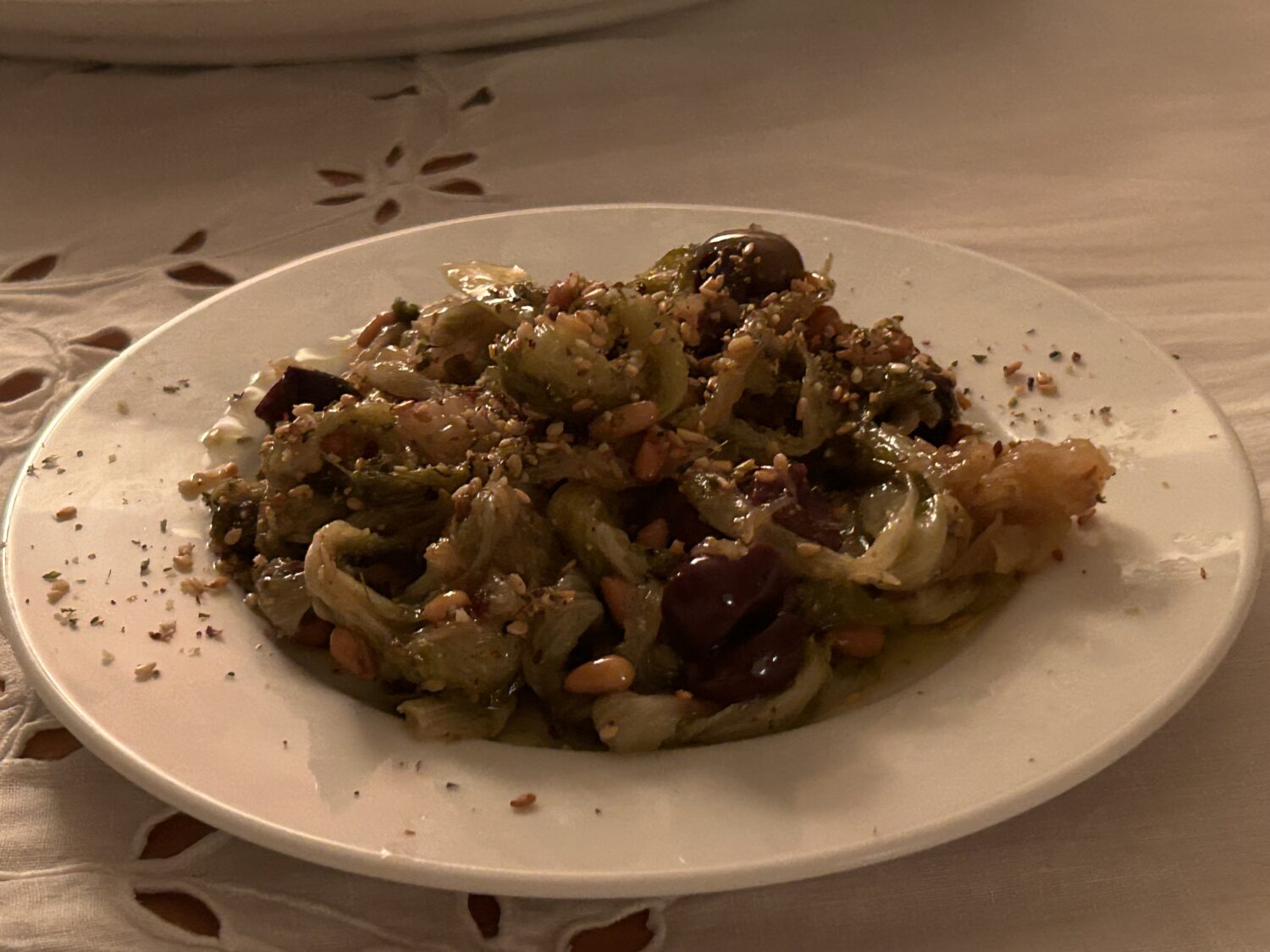Beautifully Braised Italian Bitter Greens – Escarole a L’Italienne
By Hannah HammondEscarole a l’Italienne or escarole braised in the Italian fashion: A vegetable eating experience for the real ones who know about overcooked greens.
I once had the pleasure of trying this contorni over a forced date with the Airbnb host I had just checked in with in Salerno, Italy, a few years back. He, as it happened, turned out to be a complete sleazeball who was unfortunately also the plug to the A1 fare in the area. Still, at an osteria called Il Brigante came a pasta primi of butterfly farfalle in a loose pumpkin sauce and little prawns which preceded oven-baked bass served in a pool of its own liquor. Next to the bass was a plate of the most beautifully cooked escarole, with the softest ghostly white cabbage with charcoaled rims – the result of having been cooked for an age in the oven. As peak as vegetable eating gets in Italy, in my humble opinion.
Here I add plenty of melted onions, sultanas, pine nuts and olives and on Persian new year this Wednesday even went as far as sprinkling za’atar into the base, which, dare I say it, wouldn’t have felt completely out of place on a table in the Emirate of Sicily back in the day.
Whatever you decide to throw in there, just know, that the longer you braise, the more ancient-looking the shade of green. We are aiming for a kind of slippery and alluring ‘reduced’ escarole completely soft to the bite, forming elegant oil painting-esque tendrils on the plate. Don’t be alarmed by the hue of green by the end – it’s meant to be the opposite of vibrant. Here, patience and understanding that a well-paced, slow and steady braise is the key to unlocking the inner potential of the bitter green.
As a contorni (side dish) for 4; as a plate to be eaten with crusty bread for 2
One whole escarole, trimmed and leaves detached from the base
100g taggiasca olives, or any olives your like, but lean towards the purplish brown shades
30g golden sultanas
100ml vermouth vinegar
100g pine nuts – toasted at 180 degrees until just golden
2 onions, sliced wafer thin. I’m talking translucent so sharpen your knife per favore.
Generous glug of good quality olive oil and more for finishing.
3 cloves of garlic thinly sliced
Pinch of dried chilli / crusco pepper
Splash of white wine
1 whole lemon
Seasoning to taste.

Get a large pot of salted boiling water on to very briefly blanch the entirety of the escarole.
As it’s coming to the boil, plump up your sultanas in some hot water before adding into a small saucepan of vermouth vinegar. Turn onto medium heat and reduce vinegar to syrup consistency. The sultanas will sip on the vinegar and take on an inner acidity to create jewels of agrodolce.
Squeeze a whole lemon into the boiling water to prevent escarole from browning after the blanch.
For no longer than 40 seconds, blanch your leaves of escarole using tongues, or elongated tweezers if you’re a chef, to lay out each blanched batch to sit while you finish the rest. Squeeze gently out any remaining water.
Now, get a low rise, wide-based pan (as wide as you can get) onto a low to medium heat. We want the escarole to braise like it’s lounging, spread out in single layer across the width of the pan.
Add your olive oil, into which you add crushed dried chilli and paper thin slithers of garlic. Sometimes I’ll add some rind of lemon but it’s up to you.
Add your onions seasoned liberally with salt, drawing out the moisture and start to sweat the onions with a dash of white wine to create a steam room environment and to impart a subtle acidity to the final dish.
Put the lid on to secure onion alchemy.
Sweat for a good while until the onions are absolutely melted and soft and sweet and salty, without any caramelisation.
Now using your tongues, drape in your blanched escarole laying the leaves out in a roomy layer so they mingle with the onions. Then add in your olives.
The olives give the greens that inner Mediterranea which I just love.
Next add in your sultanas.
Now put the lid back on and leave to ever-so-slowly braise – lifting the lid every now and again to watch in wonder as the shade of green matures and the flavour deepens and the whole thing becomes heavenly.
Serve with whatever you like – a piece of simply grilled white fish; a pork chop, and finish with extra good extra virgin olive oil.
With fish it’s divine, but if you want to be extra chic just eat it on its own with a glass of vino bianco per pranzo.

Hannah Hammond is a London-based chef currently working at Leo’s on Chatsworth Road. Photography by Hannah Hammond.